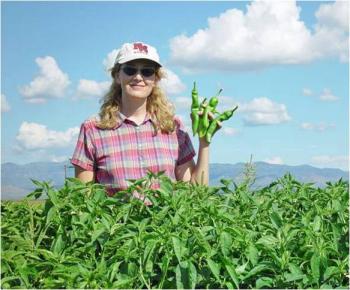Stephanie Walker, Ph.D., New Mexico State University
June 9, 2019
New Mexicans love chilies, but do we know everything about them? Chile peppers, members of the genus Capsicum, are native to the New World. After discovery of the crop by European explorers, chile peppers spread around the globe, were embraced by many disparate populations and incorporated into local cuisines. Different regions preferred different heat profiles and flavors, and specific preferences led to selection of unique varieties that contribute to the incredible diversity we see in chile peppers today. New Mexico landrace chilies, including ‘Chimayo’, have been grown in what is now northern New Mexico for more than 400 years. In the southern part of the state, the commercial chile pepper industry began when Fabian Garcia released the first milder, standardized New Mexico pod-type cultivar ‘New Mexico No. 9’ in 1913. Hungary also embraced milder chile peppers that are the main ingredient in world-renowned Hungarian paprika recipes. Other countries, including Thailand and Jamaica, are known for their use of highly pungent chile peppers in their national dishes. Finally, countries in South America have embraced Aji peppers, with their unique fruity taste. Stephanie Walker will explore the unique varieties of chile peppers grown in New Mexico and around the world.
Stephanie Walker is the Extension Vegetable Specialist at New Mexico State University where she helps vegetable growers to enhance sustainability and profitability of vegetable production in New Mexico. Her primary research interests include genetics and breeding of chile peppers. She earned her M.S. in Horticulture and Ph.D. in Agronomy from NMSU and has extensive experience in the food processing industry. She also serves on the advisory board for the Chile Pepper Institute.
Supported by Urban Enhancement Trust Fund, Haverland Carter Lifestyle Group
and Sandia Laboratory Federal Credit Union

